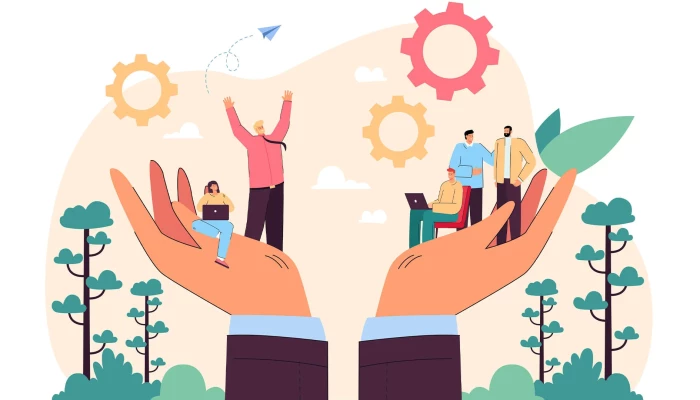Hello!
Tech trends never stay still: as new developments come onto the market, both the reach of tech and its ability to fuel its own growth is on an ever steepening trajectory. Here are the top 5 tech trends that you can expect to see making digital waves in 2022 and beyond.
Top 5 Tech Trends for 2022
Digital Transformation Solutions
In the wake of the pandemic, people have been increasingly keen to conduct transactions digitally, rather than face to face. As a result, there has been and continues to be, huge growth in the development of platforms to facilitate this, such as that provided by easysend.io digital transformation solutions.
These platforms allow businesses to convert previously manual operations or processes into digital versions while promoting a consistently high-quality customer experience.
 Expect to see this trend appearing across all industry sectors, for example:
Expect to see this trend appearing across all industry sectors, for example:
- Insurance innovation 2021 is likely to see the rise in digitalization in the field of insurance, with onboarding, and policy administration all able to be undertaken online.
- Banking and finance will continue to undergo radical changes, with digital processes for account management and loan applications becoming optimized to deliver the best customer journey possible.
As well as offering customers convenience and speed, digital transformation solutions can also streamline and standardize business practices across the board.
Also read: How to choose The Perfect Domain Name
Blockchain Technology
 Blockchain isn’t just about cryptocurrency; as a platform, it allows for the creation of secure, transparent, decentralized supply chains that can be effectively applied to the retail, financial technology, healthcare, and e-commerce sectors.
Blockchain isn’t just about cryptocurrency; as a platform, it allows for the creation of secure, transparent, decentralized supply chains that can be effectively applied to the retail, financial technology, healthcare, and e-commerce sectors.
This technology allows tangible and intangible assets to be both tracked and traded – its use can both cut down on business costs and reduce the risks involved. The key components of a blockchain are distributed ledger technology, immutable records, and smart contracts.
Distributed ledger technology – this is a record of every single transaction in the chain, viewable by all participants.
Immutable records – once a transaction has been recorded, it cannot be amended in any way. A new transaction, detailing the error, must be added instead. This lends itself to the complete transparency of the system.
Smart contracts – these are a set of rules that are applied to the blockchain, which are automatically actioned.
Blockchain’s facility for exchanging huge amounts of data quickly and securely is just one of the reasons that you can expect to see this technology being integrated into the systems that are part of our daily lives over the course of the coming years.
Using the remote work market as an example, we will show how blockchain and cryptocurrencies completely change the way of life of millions of people.
The artificial boundaries set by the current system make it impossible for hundreds of millions of people working remotely to interact and work with each other.
Dollar payments are difficult or prohibited, millions of laws, regulations, hellish commissions, taxes, regulatory agencies, the need to open bank accounts, pay accountants and lawyers - this is not a complete list of all obstacles.
 1280х720 (1).jpg) With the help of blockchain technology and web3, Quasa Connect bridges this imbalance between first world developed countries and developing countries.
With the help of blockchain technology and web3, Quasa Connect bridges this imbalance between first world developed countries and developing countries.
And most importantly, the blockchain technology used in Quasa Connect helps people to be calm about their funds and reputation, not trusting each other.
With a concrete example, we will show how the Quasa Connect blockchain service works, setting up transactions between remote workers and clients using new crypto settlement tools.
By connecting your crypto-wallet, a freelancer or customer instantly settles among themselves using the Quasacoin (QUA) cryptocurrency.
 The new crypto-settlement tools in QUASA democratize access to services traditionally tied to fiat money and banks, and open up opportunities for hundreds of millions of people. You are not tied to the currency of any country, and you can easily hire any specialist from anywhere in the world and calmly pay for his work.
The new crypto-settlement tools in QUASA democratize access to services traditionally tied to fiat money and banks, and open up opportunities for hundreds of millions of people. You are not tied to the currency of any country, and you can easily hire any specialist from anywhere in the world and calmly pay for his work.
There is no need for conversion and complexities with banking operations. No need to know the laws of different countries.
.jpg) Now the application can be used:
Now the application can be used:
- order any work;
- perform any work;
- agree on the cost of work;
- use the chat in the application;
- accept completed task;
- pay for work in QUA cryptocurrency;
- accept payment in QUA cryptocurrency.
You can also connect with TOP professionals directly by viewing their profiles, testimonials and portfolios.
.jpg) QUASA offers a service with a simple interface for end users and allows you to place orders on the most favorable terms in just a couple of clicks.
QUASA offers a service with a simple interface for end users and allows you to place orders on the most favorable terms in just a couple of clicks.
This optimization allows you to simultaneously increase the efficiency of the work of performers, thus increasing their income, and at the same time reduce the cost of completing tasks for customers.
The Quasacoin (QUA) token is listed on many exchanges. Listing and ratings from leading rating agencies CoinMarketCap and CoinGecko.
Hybrid Clouds
 One of the most important trends that this year has seen emerge is the hybrid cloud. Hybrid clouds allow a linked public and private cloud to share information – in some cases a business will have multiple public clouds linked to a single private, on-site data platform.
One of the most important trends that this year has seen emerge is the hybrid cloud. Hybrid clouds allow a linked public and private cloud to share information – in some cases a business will have multiple public clouds linked to a single private, on-site data platform.
The benefits of hybrid clouds include their inherent scalability: if data processing capacity becomes strained, clouds can be easily incorporated to handle the extra demand.
They also negate the need for costly new servers which have the potential to go unused. A huge plus for businesses using hybrid clouds is the control that they allow remaining within the organization: a third-party service does not need to be utilized, meaning that the private element of the business’ clouds can be customized to exact specifications.
Hybrid clouds are, shortly, likely to become the standard model of data storage, processing, and transfer for businesses.
Quantum Computing
Despite still being in its infancy, the potential of this technology is tantalizing, with China claiming in 2020 that it had built a working version of a quantum computer. This computer, named Jiuzhang, was able to successfully solve a calculation that a supercomputer would require two billion years to answer.
 While not likely to be widely available for some years to come, the developments in the field of quantum computing keep coming: new research suggests the possibility of merging quantum computing with neural network technology.
While not likely to be widely available for some years to come, the developments in the field of quantum computing keep coming: new research suggests the possibility of merging quantum computing with neural network technology.
This would result in a type of computing that processes photons traveling at the speed of light: the ramifications of this could transform every aspect of technology that we use today.
The AI Revolution
Artificial reality and machine learning are a huge driving force behind technical and societal trends at the moment, with machine learning algorithms being increasingly drafted in to help process the data that our digital age necessarily creates.
Hardware is now regularly becoming AI optimized as standard, and ethical questions are already being debated at the prospect of seeing, for example, AI used in the courtrooms and schools of our future.
Understanding customer behavior – especially in the changing climate, where more interactions take place online than ever before – will be crucial for businesses to grow and thrive in the coming years.
 The deployment of AI will be fundamental to achieving this, with digital self-learning technologies able to identify and analyze behavioral trends, and how they connect to purchasing habits, that manual interrogation may well miss.
The deployment of AI will be fundamental to achieving this, with digital self-learning technologies able to identify and analyze behavioral trends, and how they connect to purchasing habits, that manual interrogation may well miss.
Managing a Changed World
The pandemic has changed the world fundamentally, and permanently; the technological developments that it precipitated will continue to adapt and gain in sophistication, and eventually be rolled out across all industries and into people’s homes.
Advances in tech can be a powerfully positive force that enables us to manage the new realities of our world: in their best aspect, they can enhance our understanding of our changing societies, and help us find innovative ways to manage them.
Thank you!
Join us on social networks!
See you!






